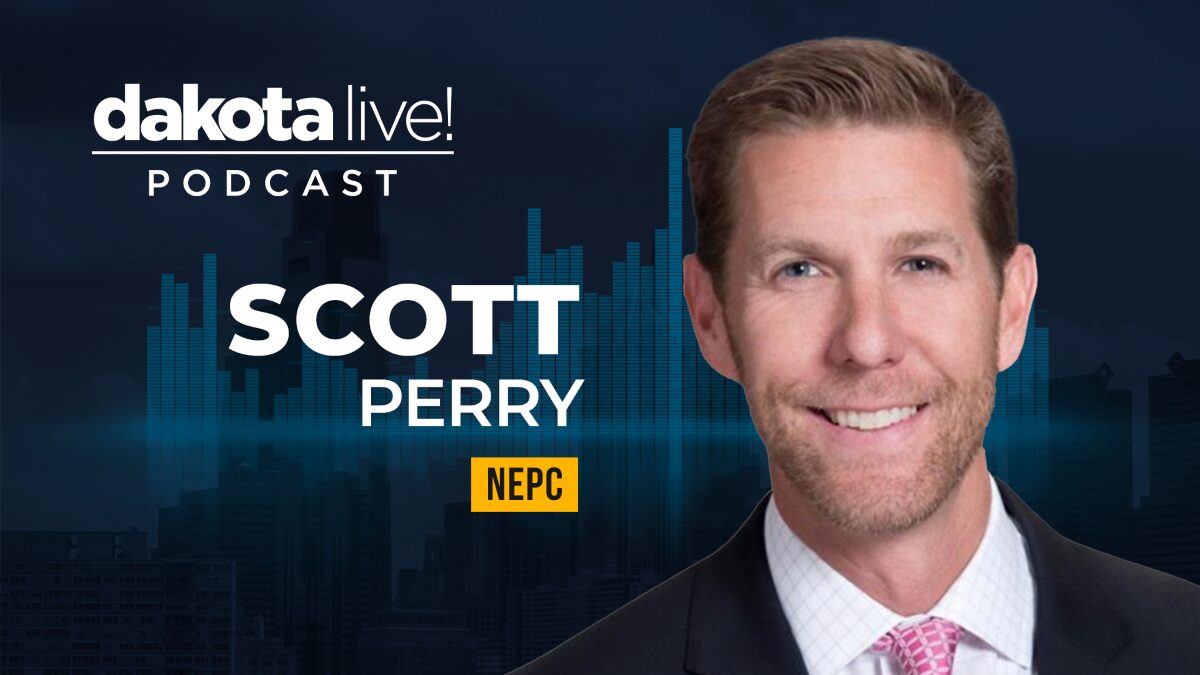Dakota Live! Podcast: NEPC Uncovered: The OCIO Model, Private Markets & What’s Next with Scott Perry
NEPC’s Scott Perry joined the Dakota Live! podcast to discuss the future of the OCIO model, manager evaluation, private markets, strategic partnerships, and more. Listen to the podcast on Spotify or Apple Podcast.
“In this episode of Dakota Live!, Robert Morier welcomes Scott Perry, Partner and Head of OCIO Portfolio Strategy at NEPC, for a candid look at how the OCIO model is evolving amid rising complexity and growing demand for private markets. Scott breaks down NEPC’s “secret sauce”—from second-level thinking and cross-asset research collaboration to a 250-point due-diligence checklist and the operational “dirty work” that truly distinguishes a discretionary partner. He also discusses industry consolidation, NEPC’s strategic partnership with Hightower, and why private market capabilities and model portfolios are increasingly bridging the gap between institutional and wealth management, all while reflecting on the role of relationships, teamwork, and even a bit of basketball in building durable client trust.”
Pensions & Investments: Consultants find new paths through AI-concentrated markets beyond tech giants
NEPC’s Chief Investment Officer, Tim McCusker, is featured in this Pensions & Investments article discussing how AI-driven market concentration is shaping today’s investment landscape and influencing portfolio construction. Visit Pensions & Investments to read the full piece.
The boom around artificial intelligence has created persistent concentration at the top end of the U.S. stock market, leading to a multistep problem for investment consultants helping their clients navigate both a fast-evolving technology and a unique investment environment.
. . .
The potential risks and rewards of AI stretch beyond just the performance of the Big Tech stocks, said Tim McCusker, partner and CIO at NEPC.
“I’m sort of thinking about it the way you have to think about technology now. There is a sector called technology, but technology is in every single asset class and every single sector. And I think you have to start thinking about artificial intelligence in the same way,” McCusker said.
. . .
“Hedge funds seem to be back on the menu in a way that they haven’t been for most of the last few years,” NEPC’s McCusker said.
Meketa and NEPC are among the 10 largest consulting firms worldwide, according to P&I’s latest survey… NEPC reported $1.7 trillion, up more than 4% from 2024.
. . .
However, McCusker said that clients looking to add geographic diversity to their stock exposures shouldn’t be too concerned that one good year has made international equities too expensive. He said relative weakness of the S&P 500 is explained more by a drop in the U.S. dollar than an underlying shift in the global economy.
“International has been a good place to be this year, but when you look through it, it’s really about the dollar more than anything else. … So it still seems like a reasonable time and a reasonable entry point to buy non-U.S. exposure,” McCusker said.
Click here to continue reading the full Pensions & Investments article.
NEPC Names Tim McCusker President; Appoints Sarah Samuels to CIO
McCusker named successor CEO, transitioning to the role in January 2027
BOSTON, December 10, 2025 – NEPC, LLC (“NEPC”), a leading investment consultant and outsourced chief investment officer, today announced the appointment of Tim McCusker as President, effective January 1, 2026. McCusker has nearly two decades of experience at NEPC, most recently serving as Chief Investment Officer (“CIO”), and will work closely alongside Chief Executive Officer (“CEO”) Michael Manning over the next twelve months before transitioning to the role of CEO in January 2027. With McCusker’s appointment to President, Sarah Samuels has been appointed to CIO, following seven years at the firm as Partner and Head of Investment Manager Selection, overseeing private markets, public markets and hedge fund investments.
“It has been a privilege to lead NEPC and work closely with our clients over the last 28 years of significant growth and change,” said Manning. “As we celebrate our 40th anniversary and look to the next chapter of NEPC’s evolution, Tim is the right choice to lead us forward. He has played an integral role at NEPC over the last two decades and has always exemplified the qualities that define NEPC: deep investment expertise, sound judgement and an unwavering commitment to our clients and our people. Importantly, Tim has worked within all of our client segments and has a keen understanding of the challenges and opportunities they face. I am confident in the positive impact that he and the rest of the leadership team will have on NEPC, our clients, and the industry.” Manning will remain CEO of NEPC through 2026, before transitioning into a senior advisory role, where he will focus on client engagement, developing emerging talent, and helping to guide the firm’s strategic direction.
In his role as CIO, McCusker led investment strategy development for NEPC and was responsible for overseeing a group of over 72 professionals dedicated to investment research across alternative investments, public markets, asset allocation, portfolio construction and OCIO investment strategy. He has been instrumental in shaping the firm’s strategic direction, advancing the firm’s business priorities – including establishing NEPC’s OCIO practice as a core investment solution – while guiding clients through complex market environments. Over the last two decades, he has held several leadership positions at NEPC and has been a member of the firm’s Executive Team since 2014.
“I have always been proud to work for a mission-driven organization that makes a real impact on society, and it is a privilege to work alongside an incredibly talented team that cares deeply about helping our clients achieve their goals,” said McCusker. “From Mike and many others at NEPC, I’ve learned the value of true leadership and how vital our culture is to our success. Having spent my career here, I know how special this firm and our offerings are, and I am excited to build on NEPC’s legacy of integrity, innovation and partnership, and evolve our business while preserving the client-first mindset that defines who we are.”
As CIO, Samuels will leverage two decades of experience as both an allocator and investor, most recently leading NEPC’s 45-person investment team and serving as a member of the firm’s Management Group. Before NEPC, she held senior roles at Massachusetts Pension Reserves Investment Management Board, the Wellesley College Investment Office and Wellington Management Company. A respected industry leader, she chaired the CFA Society Boston Board, founded the Boston Chapter of the Private Equity Women Investor Network (PEWIN), and served as Chair of the Investment Committee and Board Director at the University of New Hampshire.
About NEPC, LLC
NEPC, LLC is a leading investment consultant, private wealth advisor, and OCIO provider, serving over 400 retainer clients and $1.7 trillion in total assets. Combining a proprietary investment team dedicated to the long-term challenges facing investors with our client-centric model, NEPC builds forward-looking investment portfolios for institutional investors, ultra-high-net-worth individuals, and families. To learn more visit nepc.com.
Contact
Prosek Partners for NEPC
Chaneigh Bernard
Prosek Partners
[email protected]
Institutional Investor: NEPC’s McCusker to Succeed Manning as President… and CEO (in Due Course)
Institutional Investor spoke with Michael Manning, Tim McCusker, and Sarah Samuels about NEPC’s newly announced leadership transition, offering an inside look at the firm’s long-term succession strategy. Visit Institutional Investor’s website to read the full exclusive or read excerpts below.
NEPC’s longtime investment chief Tim McCusker will succeed Michael Manning to lead the $1.7 trillion investment giant — first as president, then as CEO — as part of a multiyear transition plan.
. . .
Sarah Samuels, a partner at NEPC, has been appointed to CIO as part of this succession plan.
. . .
“A really important part of this transition is to create continuity,” McCusker said. “That’s not to say we won’t change; NEPC will continue to evolve… we [just] want to do it in a way where our DNA, our values, our culture, don’t change.”
. . .
“We’re going to maintain the strength of the investment team [and] enable our people to stretch and grow,” Samuels said.
Click here to read the full article on the Institutional Investor site.
NEPC Strengthens Leadership Team with Promotion of New Partners and Principals
BOSTON–December 3, 2025—NEPC, LLC (“NEPC”), a leading investment consultant and outsourced chief investment officer, today announced the election of five new Partners and the promotion of four new Principals, reinforcing the firm’s ongoing investment in leadership, talent development, and long-term client excellence. These appointments will take effect on January 1, 2026.
2025 marked another year of meaningful growth for NEPC. These leadership advancements reflect the firm’s commitment to building a deep bench of seasoned professionals who bring insight, continuity, and forward-thinking solutions to an evolving investment landscape.
“Developing exceptional talent is central to who we are as a firm,” said Michael Manning, CEO of NEPC. “These individuals exemplify the expertise and integrity that define our culture, and we are proud to celebrate their continued growth and leadership within NEPC. Each of them represents an area of strategic importance for NEPC and we are excited to recognize their impact on our clients and our firm.”
The newly elected Partners are:
Aaron Chastain, CFA, Corporate Team
Nick Mann, Private Markets Investment Team
Emma O’Brien, Defined Contribution Team
Mikaylee O‘Connor, Defined Contribution Team
Brian Parnell, OCIO Team
The new Principals are:
Sujatha Bhat, CFA, CAIA, OCIO Team
Colton Lavin, CFA, Private Debt Investment Team
Nina Petkova, Global Equity Investment Team
Shahin Shafai, Information Technology Team
Manning also stated, “Each of these leaders plays a vital role in strengthening our firm and advancing the high standard of service our clients rely on.”
For more information on NEPC’s employee workforce and to explore open opportunities, click here.
About NEPC, LLC
NEPC, LLC is a leading investment consultant, private wealth advisor, and OCIO provider, serving over 400 retainer clients and $1.7 trillion in total assets. Combining a proprietary investment team dedicated to the long-term challenges facing investors with our client-centric model, NEPC builds forward-looking investment portfolios for institutional investors, ultra-high-net-worth individuals, and families. To learn more visit nepc.com.
Media Contact
Chaneigh Bernard
[email protected]
PlanSponsor: How Employers Can Afford to Fund Auto-Features
In this PlanSponsor article, NEPC’s Mikaylee O’Connor shares her perspective on the value of automated plan features and practical strategies employers can use to support and fund them. Read the full piece on PlanSponsor’s website.
The retirement security of millions of working Americans is becoming increasingly reliant upon an asset structure that is likely less familiar than its ubiquitous counterpart, but powerful to many.
. . .
Today, more than half of defined contribution retirement plans have adopted automatic enrollment: According to NEPC’s 2024 Annual Plan Trends & Fee Survey, released in March, 54% of DC plans used auto-enrollment and 59% offered auto-escalation.
. . .
“Starting early and saving enough are the most powerful drivers of retirement success, and auto-enrollment and [auto-]escalation make both happen seamlessly,” wrote Mikaylee O’Connor, principal in and head of DC solutions at NEPC LLC, in a response to emailed questions. “These features remove friction, boost participation and lead to more financially secure employees—translating into higher productivity, engagement and satisfaction.”
. . .
NEPC’s O’Connor wrote to PLANSPONSOR that in addition to adjusting allocations within the retirement budget, plan sponsors might also consider integrating health care and retirement into a single benefits strategy. Opportunities often exist in health care to reduce costs by revisiting plan design and better understanding current fee arrangements—potentially leading to renegotiations or better alignment of overall incentives, O’Connor explained.
For health plan design, sponsors can evaluate options such as offering high-deductible plans instead of preferred provider organizations, O’Connor wrote. Fee reviews can include examining provider fee transparency—potentially revealing opaque incentives or compensation structures—and assessing payment accuracy, as a significant portion of payments are often miscalculated.
. . .
O’Connor sees another opportunity in the auto-feature space.
“The next frontier is auto-distribution, creating a paycheck-like experience for retirees,” wrote O’Connor. “This keeps assets in the plan while simplifying income delivery—a win-win for sponsors and participants.”
Click here to read the full article on the PlanSponsor site.
Chief Investment Officer: University Endowments Returned to Growth in 2025
Chief Investment Officer features insights from NEPC’s Colin Hatton in this in-depth look at endowment performance in fiscal 2025, highlighting the role of private markets, liquidity considerations, and shifting allocation trends. View the full article on CIO’s website to learn more.
Higher education institutions saw strong returns across asset classes, especially in equities, and significant exposure to themes related to digital assets and artificial intelligence.
. . .
Colin Hatton, a principal in NEPC’s endowments and foundations practice, explained that the firm still expects private market assets to provide strong returns.
“Over the long term, we still believe that private markets will outperform the public markets,” Hatton says. “However, we’ve seen that turnaround the last three years. If you look at a 10-year time period, those with heavy alternative allocations did outperform, and if you go back beyond that as well.”
. . .
Hatton notes that because secondary sales lead to a decline in the value of the portfolio—because the assets are generally being sold at a discount—endowments are examining how the haircut will affect spending and distributions to the university.
“I think another thing that institutions are thinking about is how it will affect their spending if they go and do a secondary sale,” Hatton says. “The effect that that can have on the spending policy and the support for the institution is another consideration that these groups are having to think through as they go through this.”
Click here to read the full article on the Chief Investment Officer site.
Pensions & Investments: With AI driving public — and private — equities, university endowments return higher for fiscal year
NEPC’s Colin Hatton shares insights with Pensions & Investments on the evolving role of venture capital and real estate within higher education endowments. The article explores how endowments are navigating market volatility and uncovering new opportunities across asset classes. Visit Pensions & Investments to read the full piece.
In a year marked by political headwinds, budget cuts and volatile markets, U.S. colleges, universities and associated foundations scored positive returns for a third straight fiscal year.
. . .
Compared to five years ago when venture capital was producing stronger returns, there’s been reduced appetite for the asset class over the past few years, said Colin Hatton, principal for endowments and foundations at $1.8 trillion investment consultant NEPC.
Venture capital can still provide returns with strong upside, though clients should have a strong understanding of the associated risks of the asset class, he added.
“We would expect many higher education endowments to continue to invest in the space as they will require higher expected returns to meet potentially higher spending rates,” Hatton said.
. . .
The real estate industry is continuing to recover, NEPC’s Hatton added. With that said, he noted subclasses such as industrials, warehousing and datacenters are seeing heightened interest from endowments and foundations looking to diversify.
Click here to continue reading the full Pensions & Investments article.
Chief Investment Officer: Institutional Investors Begin to Embrace ETFs
NEPC’s Will Forde shares his perspective in this Chief Investment Officer article on the growing role of ETFs in institutional portfolios. Read the full article on CIO’s website for insights from industry leaders.
As exchange-traded funds continue to become a bigger part of the investing landscape, institutional investors are using the vehicles more broadly.
. . .
“Will Forde, head of marketable equities at NEPC, agrees that ETFs offer niche exposure and tactical opportunities in a way that is hard to replicate with other vehicles.”
. . .
“ETFs can be easier operationally and cheaper to use than traditional index funds for NEPC’s smaller institutional clients, Forde says, since these smaller investors do not have the size and scale to negotiate favorable pricing.
Forde says his clients will use ETFs if they need to quickly implement tactical exposure, such as hedges. He also reports seeing them used for portfolio completion, such as if a client has a structural bias, like a country underweight. For taxable clients, ETFs are useful in tax-loss harvesting.”
. . .
“Forde sees use cases for ETFs evolving as asset owners continue to get comfortable with the vehicle.
‘People get really creative with how to use things that even five or 10 years ago seemed pretty basic, but now they’re using them in different ways,’ he says.”
Click here to read the full article on the Chief Investment Officer site.
PitchBook: Harvard sees record donations to endowment amid mounting expenses
NEPC’s Colin Hatton was recently quoted in this PitchBook article discussing the growing reliance on philanthropy to offset structural financial pressures, even for the most well-resourced institutions. Read the PitchBook article here.
During one of Harvard University’s most challenging years, donors helped fund the endowment, which in turn supported the university’s operations.
. . .
“A lot of educational institutions are struggling with balancing their operating budgets, and you’re seeing a number that are running deficits. In some cases, they’re using the endowment to help bridge that deficit,” said Colin Hatton, a principal at NEPC, where he advises endowments and foundations.
Hatton said endowments’ mounting contributions to university operations, in addition to rising inflation expectations, has many of his clients planning to increase their returns in the coming year. NEPC, he said, recommends funds do this through strategic asset allocation decisions, particularly by prioritizing an equity-centric portfolio, allocations to private markets and fixed income exposure, including private debt.









